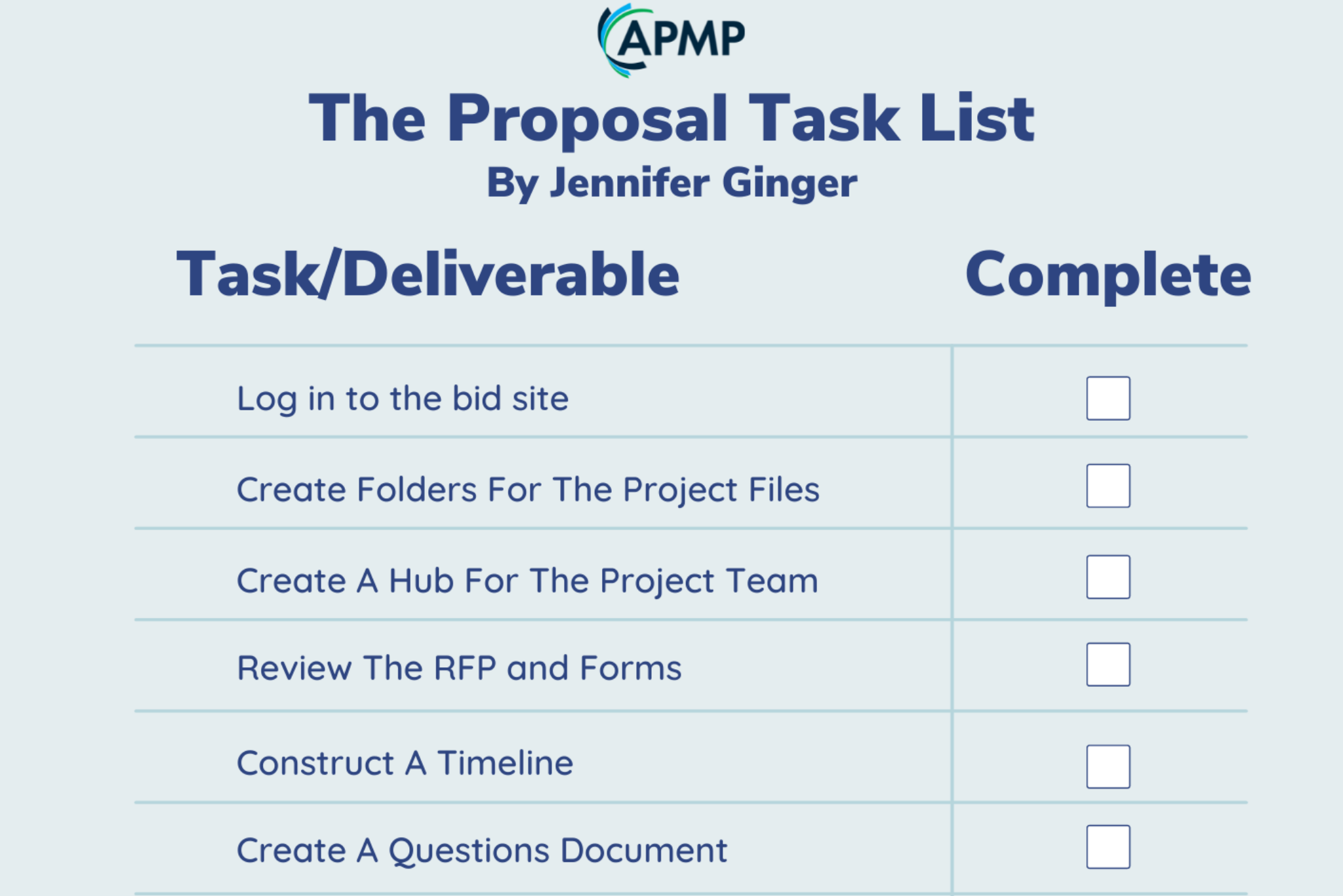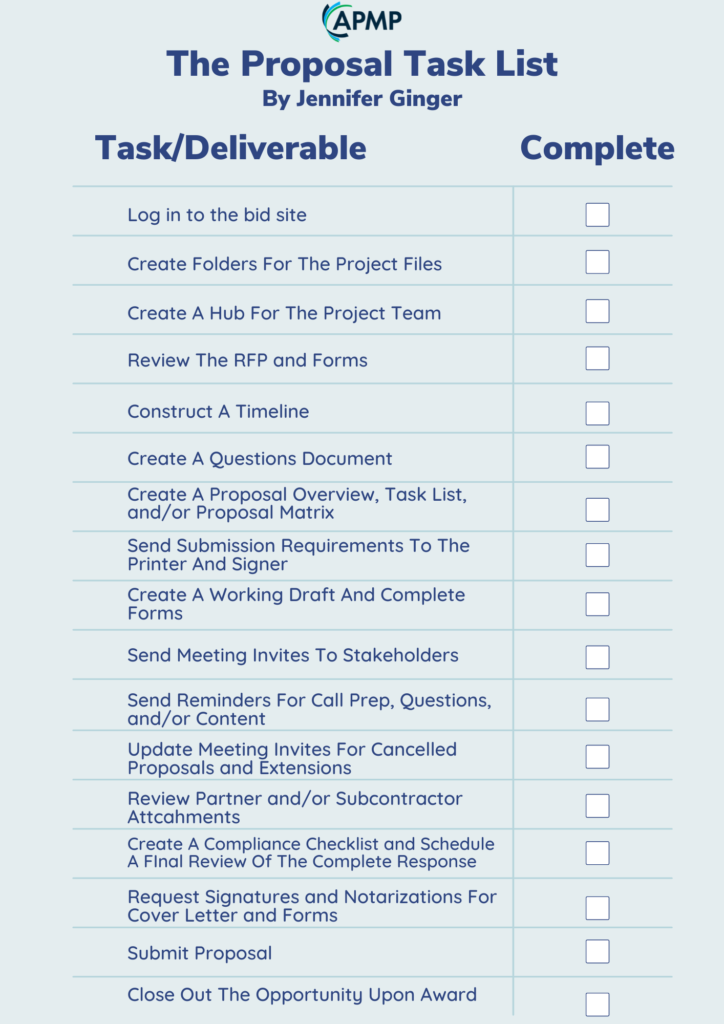When I first started writing proposals, I didn’t realize how much time would be spent on administrative and project management tasks, like coordinating schedules of stakeholders and, essentially, planning a series of events people knew they had to attend but weren’t thrilled to participate in. Depending on the volume and complexities of proposal requests, it was difficult to keep track of who was responsible for deliverables – let alone focus on developing content to address RFP requirements. So, I created a cross-industry task list that I tailor for each proposal to ensure that nothing essential is overlooked throughout a process that can be anything but predictable. Because while the project team is working toward a unified goal (win the bid), everyone involved has their own priorities and objectives. As proposal writers, our objective is to create compliant, timely responses. Though the methods to reach this objective may vary, I’ve found that leveraging a framework focused on efficiency and organization enables me to lead the proposal development process with confidence.
As each workplace has its own priorities and preferences for communication, file storage, and collaboration tools, the list that follows is meant to be adapted to align with internal processes and needs.
Log in to the Bid Site
Review submission requirements (are they requesting one complete file or separate files) and download bid documents. Check back regularly and share the addenda with the team, noting any new requests or requirements.
Create Folders for the Project Files
Save relevant project files (customer documents, working drafts, submission) and communications in one location that’s easy to access and navigate. Optional: rename saved emails to quickly identify its contents and source.
Create a Hub for the Project Team
Whether a collaborative workspace or an email group, use an easily accessible method or tool to keep everyone up to date, on task and engaged. Share navigation details and instructions on where to upload files and how feedback and edits should be provided (example: comments within the document, tracked changes, via email). While it can be helpful to be consistent in approach, it’s also important to be flexible (within reason) based on the team’s preferences and deadlines.
Review the RFP and Forms
Note discrepancies, concerns, and conflicts of interest to discuss with the team and, potentially, ask the RFP contact. Notify the team of major concerns as soon as possible.
Construct a Timeline
Note proposal due dates, pre-bid meetings and Q&A or addenda releases. Internally, consider PTO, partner/subcontractor deadlines, proofing and production (internal reviews and approvals). If possible, factor in time for late responses and unforeseen delays.
Create a Questions Document
Designate someone on the project team to send the team’s compiled list of questions to the RFP contact. Having one point of contact helps establish a point of contact for further communications and helps the company appear organized.
Create a Proposal Overview, Task List and/or Proposal Matrix
Note which responses are required for compliance and which responses are optional. Identify what should completed by members of the project team (example: business development, sales, legal). Ask project team members how much time is needed to complete their assigned tasks and ensure the date given fits into the proposed timeline.
Send Submission Requirements to the Printer and Signer
Note signature types (digital or wet; note color, if specified) and production requirements (example: tabs, recycled paper, double sided printing).
Create a Working Draft and Complete Forms
Engage resources that aren’t included in the project team as needed. Detail the requested task, the due date of the task and the proposal timeline. When sharing the draft with the project team, reiterate instructions on where to upload files and how feedback and edits should be provided.
Send Meeting Invites to Stakeholders
Note in the invite what will be discussed in the meeting and attach or link to relevant files. (Optional: create templates for communications.) In meetings, facilitate discussions and encourage participation by reviewing the status of task list items. Ask what the escalation plan is if contributions aren’t received when expected.
Send Kickoff Recap Email
Recap what was discussed, note the next steps, and include the proposed timeline.
Send Reminders for Call Prep, Questions and/or Content
Detail expected contributions and the proposal timeline. Ask what the escalation plan is if contributions aren’t received when expected.
Update meeting invites for Canceled Proposals and Extensions
Readjust priorities and task due dates as needed. Note any new requests or requirements listed in the addenda.
Review Partner and/or Subcontractor Attachments
Confirm what the project team wants to include (ask what will help the customer make a decision without feeling overwhelmed) and where it should go within the response.
Create a Compliance Checklist and Schedule a Final Review of the Complete Response
Confirm that required sections are included and that responses address the question/requirement.
Request Signatures and Notarizations for Cover Letters and Forms
Include the page numbers and titles of the pages and/or sections that need to be signed and notarized. Note any special instructions (example: initials, corporate seals).
Submit Proposal
Send confirmation to the team and save final files.
Close Out the Opportunity Upon Award
Follow internal processes for award/non-award.
AUTHOR INFO
Jennifer Ginger has been writing proposals since 2017. Currently a proposal specialist at CDW Government, she enjoys helping strengthen processes and developing content that addresses company and customer needs. Connect with her on LinkedIn.




Excellent advice. Many folks do not know what happens on the back end. It’s more than just pulling resumes. Now multiply that by 3 if you are super busy. Great article.